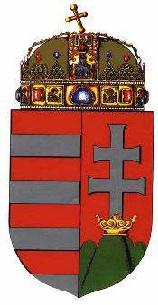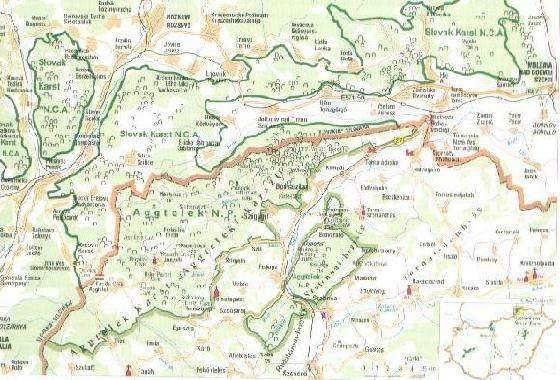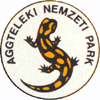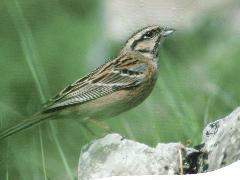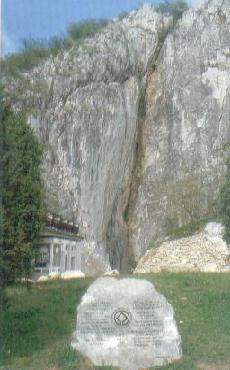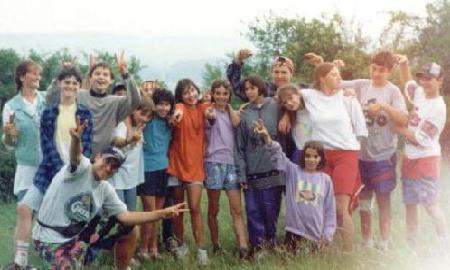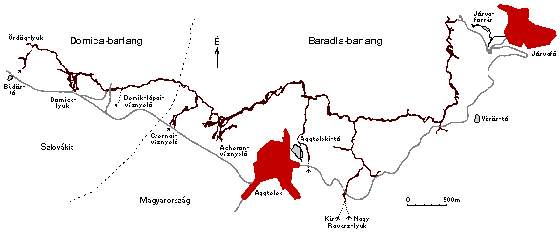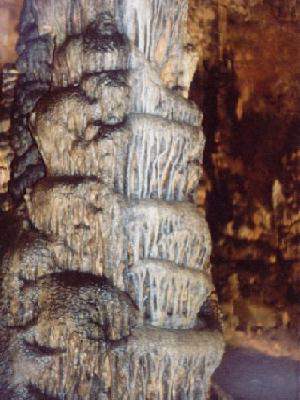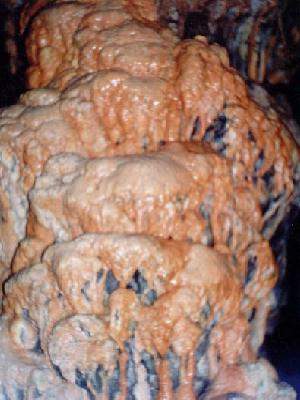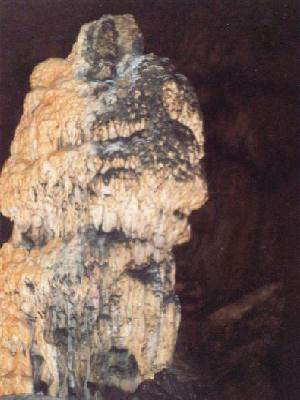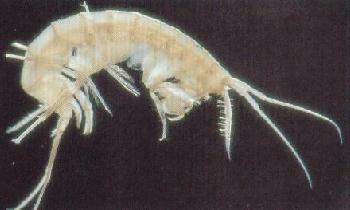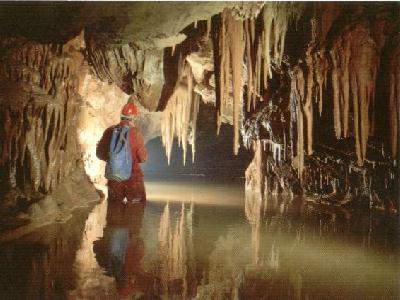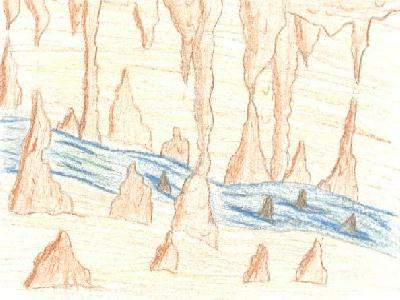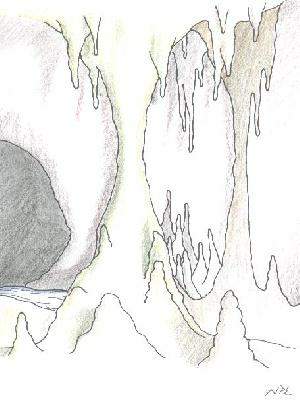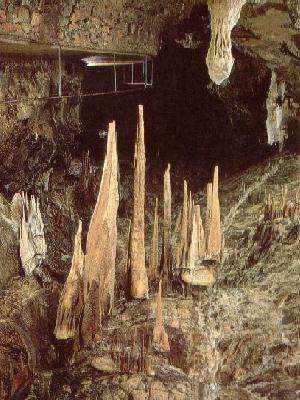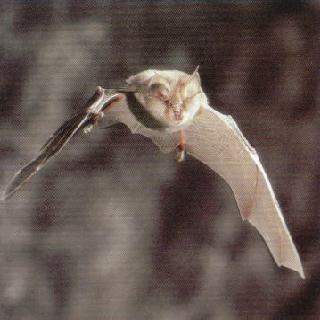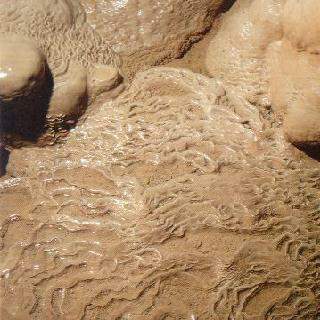|
|
National Natural Protected Areas in Hungary |
|
|
|
- Cave Lands - |
|
|
|
The Aggtelek National Park
The various parts of the national
park land were formed in different, rather distant geological
periods. The history of their geological evolution has been
different. They reached their present location in the Cainozoic
era as a result of horizontal movements triggered by tectonic
forces. The ground rock in most of the territory was formed about
230 million years ago in the Triassic period of the Mesozoic era.
It is the characteristic of theses rocks that determine the
features of the landscape, and because of these the region’s
world-famous caves and other karst formations first saw daylight.
Such formations, as well as some other rock associations and
their explorations that now serve as key geological sections,
are unique in Hungary.
The present
form of the Aggtelek Karst Region is basically the result of
karst phenomena and processes related to the destruction of the
limestone ground rock. Nearly all the typical phenomena of
temperate zone karstification, that began in the Ice Age and have
occurred ever since, can be found here in a relatively small
area. However, besides natural forces, human activity has also
played its role in shaping landscape.
In some areas which were once forested, the trees dissolved the milestone lying beneath the topsoil by acids emanating from their roots, and thus created tube-like holes in the ground. Deforestation and the ensuing agricultural utilisation of the land opened the door for precipitation to erode the soil unhindered. The ground rock was thereby revealed, and the remnants of the vegetation left in its tiny cavities (the so-called ‘root karrs’) gradually decomposed. This rugged, riddled and barren surface is called ‘karr’ or in folk terminology the ‘devil’s poughland’. The most beautiful example of such a karr formation is hillside of Tóhegy (Lake Hill), located just above Aggtelek. The national park is a genuine open/air museum of surface karst phenomena. The wooded plateaux are dotted with holes like a piece of cheese: these are sink holes as well as dolinas, where the ceiling of a dissolved hollow collapsed. At some places the remains of karst ravines and collapsed former caves stretch among the limestone blocks.
The natural opening of the Baradla Cave at
Aggtelek, with the plaque confirming the World Heritage satus.
In the course
of karstification, the precipitation becomes acidic from the
carbon-dioxide dissolved by water from the ground. As the acid
water infiltrates the crevices in the limestone, it dilutes them
and thereby the way for the quartz pebbles to be washed down by
the rain into the underground fissures. The pebbles polish the
inner surface while calcium carbonate precipitates from the water
slowly dripping through the hair-line crevices, creating a rich
layer calcium-carbonate dripstone formations on the walls and
floor of the evolving caves. The stalactites and stalagmites,
coloured by multifarious minerals washed underground by the
rainwater, together with dripstone columns, draperies, thin hay
dripstones, coralloids and coral-like formations, helictites,
curves dripstones and rimstone terraces glittering with calcite
crystals, constitute a uniquely rich underground treasure-trove.
Altogether,
there are more than 700 caves known to exist on the Aggtelek
Karst and the Slovak Karst, which together form an integral whole
by virtue geological and geographical features. Among them, one
can equally discover large, horizontal with an active brook and
deep almost vertical shafts in the north-eastern parts of the
national park. Their treasures have been included in the World
Heritage List. Here shall stand only a few rapturous lines from
the Canadian geologist Lloyd Trevor about their enchanting
impression of theses miraculous caves:
“In the
course of my entire tour of Europe, obtained the deepest and most
lasting impressions when visiting your Aggtelek Cave… It is not
only the scientific significance of your cave that is
immeasurable, but the gigantic horizons of its underground
cavities and the enthralling mass of the crystal formations that
make even the lay visitor come to realise that this unparalleled
masterpiece of nature has been called to existence by the very
same geological forces and processes that still play a major role
in developing the crust of earth.”
A group of student near the entrance of the Baradla Cave - By Aranyi Laci
The Aggtelek
National Park, thanks to its geographical position and geological
structure, has very special climatic and hydrological conditions.
The amount of precipitation falls short of the average of medium
elevation hills; this is because the area is surrounded by higher
hills and mountains on all sides. The annual mean temperature of
the region is 10
°C, and the daily figures are below the
national average. In deeper valleys (in the period when deciduous
trees have their foliage( and in the caves, the level of air
humidity can approach 100%. A special characteristic of the
region’s clear air is that the pollen of several plants causing
allergic symptoms, cannot be found in the Park’s area.
The most
important characteristics of the flora and fauna of the Aggtelek
Karst are their marginal position and transitory character. In
terms of phyto-geography it belongs to an independent floral
district that has evolved under karst conditions at the
overlapping of Carpathian and Pannonian floral sectors. The
enormous wealth in species and habitats that this mostly forested
area possesses in indicated by a series of species with a wide
range of ecological needs and characteristics.
One of the
most characteristic forest communities of the karst land is the
mixed hornbeam-oak wood, which provides a general basis for the
numerous flora and fauna association. One can find several steppe
and wooded steppe species in the warmth-loving oak forest lying
on southern slopes, and there are sub-Mediterranean and middle
eastern species in Downy Oak dominated karst scrub forests and in
rock grasslands. This is the only place on earth where the
International Red Book species íof the Tornaian Golden Drop can
be found, which naturally enjoys strict protection, and the only
Hungarian sites of the Austrian Dragonhead are here.
The
mosaic-like communities of scrub forest and rock grasslands
treasure a spectacularly rich fauna. Especially, the orders of
butterflies and Orthopterans (grasshoppers, crickets) are
represented here by rare species. The invertebrates of these
multicoloured and flower-rich grasslands include a large
grasshopper, Saga pedo, and Clouded Apollo butterflies. Tiny
Snake-eyed Skinks and more corpulent Green Lizards lurk in the
crevices of rocky outcrops that divide wind-ruffled fields of
Feather-grass. The beautiful scarlet Pyramidal Orchid represents
the orchid family in the secondary hillside meadows, while in
autumn one is bound to witness the blooming of various blue
Gentian species.
The stream
valleys dividing the karst land are garlanded by pretty resinous
alder groves. A rare amphibian of the cool, shady stream valleys
is the Fire salamander that is the logo of the Aggtelek National
Park. The cross bog meadows with Cotton-grass and wet meadows are
a riot of colour in the lower river sections.
A group of student next to the exit of the Baradla Cave, just in the Hungarian-Slovakian national border - by Aranyi Laci
A Europe-wide
rare nesting bird of tall sedges is the Corncrake. The national
park gives home to the largest Hungarian population of the Hazel
Hen, the only grouse native to Hungary. Here is the nesting place
of the rarest breeding songbird of the country, the Dipper, and
the Imperial Eagle also broods in this area. The most frequent
bird of prey is the Common Buzzard. In the past decade several
large predators, that were once native to this region, such as
the Wolf and the Lynx have resettled in the national park. oMan has been constantly present
in the territory of the Aggtelek karst since prehistoric age. The
extensive forest teeming with game animals attracted hunting
tribes and the cultivation of land began in the Neolithic period.
The tools and remnants of the artistic line-decorated earthware
of the Bükk culture were found in large numbers at Aggtelek.
Archaeologists also unearthed several fine, thin-walled ceramic
items ornamented by bundles of lines. The late Bronze Age and the
early Iron Age are represented by golden bracelets, rings and
bright black bowl fragments. Some pottery has also remained from
the Roman Age.
The
settlements of the region were established in the Middle Ages. As
soon as the Tartar invasion ended, the reconstruction work began.
Not only churches were erected by the hundreds in the country,
but monasteries were also established one after the other. At a
distance of only about an hour’s walk from the Martonyi
settlement, there are the ruins of a Pauline cloister, founded in
1947, but now overgrown by vegetation. The round church in
Szalonna, dating from the time of the Árpád dynasty, is worth
visiting for the fragmented frescos on its inside walls, and the
Romanesque church in Rakacaszend, with the straight back wall of
its chancel is also noted for its precious fresco fragments and
painted wooden ceiling dating from 1657. The twin-chancel Roman
Catholic church in Tornaszentandrás in unique among Hungarian
protected monuments.
The 13th
century Protestant church, since the rebuilt several times
furnishes an impressive view with its sunk panel ceiling, wooden
shingle roof and wooden belfry. The Romanesque church in Ragály
is much simpler, but its not, without a spire, has stood in its
place virtually unaltered since the 13th
century. The painted sunk panel ceilings of the Jósvafő and
Tornakápolna churches are valuable pieces of art dating from the
18th century. The pieces of wooden
furniture (e.g. benches, pulpits and ceilings) in the above
mentioned churches and products of master painters belong to the
most beautiful relics of Hungarian folk ornamentation. One can
also discover cemeteries with beautiful wooden grave-pots at
peripheral villages in the Aggtelek karst, namely in Aggtelek,
Teresznye and Jósvafő.
Similarly to
the other regions of the country, castles were built one after
the other in the second half of the 13th
century in north-eastern Hungary. To the north of the Szögliget
settlement, the Szád Castle was erected on Szárd Hill in the
1250’s by the command of King Béla IV in defence of his domain
in Torna. This castle was reckoned to be one of the largest
Hungarian castles at that time. In the garden of the Baroque
castle in a protected park in Tornanádaska, a 15th
century well from Venice can be seen, equipped with an iron winch
structure. The building presently as an institution for the
handicapped. The medieval settlements surrounding the territory proper of the national park stretch out along a valley or along a road, and predominantly have a longitudinal structure dominated by one main street. The bulk of their dwelling houses were built at the turn of the century or afterwards. The region has retained its natural, historical and cultural heritage almost intact, accompanied be elements of traditional peasant agriculture. Visitors of the Aggtelek National
Park are offered a rich programme during any season. The
Baradla-Domica cave system is an outstanding sight which can be
visited throughout the year with guided tours of different length
and difficulty. The alternatives range from ground tours (village
walks, eco tours, botanical tours), ornithological trips, visits
to Hucul stud (kept for the purpose of genetic preservation) and
horse riding excursions to the cultural highlights of the
villages nearby. Student groups can participate in all tours
organised by the National Park with a 50% reduction in price.
Among the numerous programmes organised for tourists and among
cultural events in general, the annual series of cave concerts
stands out vividly. Guests wishing to have a profound rest and
perfect relaxation are most cordially welcomed by the various
accommodation facilities operated by the park management, like
the Baradla Tourist Hotel and Camping in Aggtelek, and the Hotel
Tengerszem (Hotel Tarn) in Jósvafő, as well as by the cheap
pensions and tourist houses in the surrounding settlements.
The caves of the
Aggtelek Karst
The
Map of Baradla Cave
The
list of the World’s Cultural and Natural Heritage sites
includes numerous caves, mostly designated because of their
cultural-historic value. Caves as natural formations have so far
only acquired World Heritage status in four cases. After a joint
application by Hungary and Slovakia, UNESCO’s World Heritage
Committee included the caves of the Aggtelek Karst and the Slovak
Karst in its list of the world’s most treasured natural assets
at its meeting held in Berlin, in December 1995. The Mammoth Cave
(USA, Kentucky) with an extension of 560 km below surface, and
registered as the world’s longest cave, was first included in
the list in 1981. Following this, in 1986, the Skocjani Cave
(Slovenia), which forms a subterranean riverbed with the
world’s highest water output, was put on the list. Finally, in
1995 – at the summer time as the caves of the Aggtelek and
Slovak Karst – the caves of the Carlsbad National Park (USA)
were included, and among its numerous caves – along with its
name-giving cavern – there is a cave, which is considered the
most beautiful in the world.
The
area of Aggtelek and Slovak Karst (once called the Gömör-Torna
Karst) is divided by the Slovak-Hungarian state border,
nevertheless it forms an integral unit not only geographically,
geologically hydrologically and ecologically, but also from the
point of view of cultural history, and more than 700 hundred
caves are known there. This subterrain world of diverse origin
embodies one of the most complex sets of temperate karst
formations yet discovered in mountains of medium height. With its
abundance of forms versatility of speleothems, unique fauna, as
well as its archaeological and historical relicts, this
underground world proudly occupies a place in the first category
of the Natural Heritage list.
Of
the caves classified as a World Heritage site, 280 lie beneath
the surface of today’s Hungary. This figure constitutes
approximately 8% of the more than 3500 registered caves. The
length of seventeen caves exceeds 200 metres, and eight caves are
over 1000 metres long. Fifteen caves stretch more than 50 metres
below the surface, and six descend beyond 100 metres. This is
where Hungary’s longest and third longest caves are situated.
The length of the Baradla-Domica system is put a 25 km, and that
of the Béke (Peace) Cave at 7.2 km. The estimated length of the
latter is expected to increase in the near future as a result of
recent exploration. Hungary’s second deepest cave, the
Vecsem-Bükk Shaft which has a spectacular entrance and has been
explored to a depth of 236 metres, is also located in the
Aggtelek Karst right on the Slovakian border.
A lonely one - by Aranyi
Laci
The
most famous caves at Aggtelek are those with origins, which can
be traced back to streams. The dissolving formed these caves and
polishing effect of watercourses wove their way below the hills
via swallets. Many of theses, such as the Béke and Kossuth
Caves, have water streaming in them the whole year round,
however, there are also caves in which water only enters after
winter snows have thawed or after heavy rains. Caves with such
temporary activity include the Meteor, Szabadság
(Liberty) and
Vass Imre Caves. In the southern, lower-lying parts of the karst
region, the nearly horizontal caves with streams and shorter or
longer tributaries joining the main stream, are typical. In
upland areas the water, which flows underground through
seasonally active swallets, forms steep caves with a gradual and
vertical shafts divide ‘step-by-step’ decline and which.
However, the vast majority of this type of cave has become
inactive due to karst activities, so the channels in them were
filled with sediment.
Another
major cave type includes the vertical system that is presumed to
have developed as a corollary of the dissolving effect of waters
seeping through surface cracks. This type of cave is typical of
the region’s karst plateau. Within this type there are 64 caves
belonging to a sub-class characterized by parallel shafts. These
shafts, whose walls could be likened to those of a well, are
concentrated
in the area of Alsó-hegy (Lower Hill) where they appear in
unique density. Around d a third of the known caves here are
located within half a square kilometre. 22 that have been formed by ascending waters complement the diversity of cave types. Theses are thought to have been created by the dissolving effect produced when warm and lukewarm waters mixed together in the limestone block of the Esztramos Hill. This giant block is located in the Szalonna Karst to the south/east of the main karst region.
A group of Dripstones - in a
picture postcard The caves also contain numerous spectacular mineral deposits, the
most common being calcite and aragonite, along with gypsum and temporarily
appearing ice-formation. So far, 20, of the 25 existing basic types of carbonate
speleothems have been identified, a fact regarded by the international
scientific community as a real rarity. The most common forms are the
stalagmites, stalactites, draperies and flowstones, all which vary in shape,
size and colour, and often cover large surfaces. Rimstone dams, pools and cave
pearls, which are linked to dripping or flowing water, are also frequent.
Likewise, aragonite bushes, popcorn-ícoralloids, helicties, cave rafts, moonmilk,
cave shields and shelfstone resulting from seeping and stagnant waters, can be
found. The coralloids in the Rákóczi
Cave, registered within the
international scientific literature summing up minerals of the world, are said
to be one of the world’s best displays of the type.
The Baradla-Domica cave takes the most
prestigious place among the caves registered as world heritage being the longest
temperate climate cave that contains an active stream and is richly decorated by
dripstones. Domica is the 5.6 km long section of this multi-entrance system that
extends below Slovakia. Baradla, which in the last century was considered to be
the second longest cave in the world, was ranked eighth in 1965, fourteenth in
1969 and twentieth in 1973. Today, it unfortunately does not even rank amongst
the 100 longest cave in the world. However, in the temperate zone, none of the
active stream caves that are longer than Baradla contain such a wealth of
speleothems. The first written document, which – although with the wrong
determination of position – mentions the Baradla Cave’s petrified dripping,
dates from 1549, and the first Hungarian language description appears in a
schoolbook written in 1788. Since the end of the 18th century the
cave has attracted many scientists from abroad who published their findings. The
Englishman Townson visited the site as early as 1794, Hunter soon after in 1799,
with the Pole Staszic following in his footsteps in the same year, the Russian
Glinka visited Baradla in 1808, and the Frenchman Beudant arrived in 1818. The
cave’s first sketch map, drawn by the Hungarian Sartory
József, is regarded in international literature as the first map of a cave
worked out by an engineer. After Vass Imre discovered an extension to Baradla in
1825, it became the world’s longest charted cave of the time. Baradla was also
one of the very first caves to be opened to tourists. There were organized tours
to the cave at the beginning or the 18th century, and in 1806 – to
ease wandering – bridges, steps and footpaths were constructed, and when
high-ranking guests paid a visit the cavern was even furnished with candles to
illuminate the way. A connection between the Baradla and Domica caves was
predicted as early as 1801 and finally proved in 1932.
The Aggtelek Well Shrimp is
a characteristic inhabitant of the underground waters of the
Aggtelek Karst.
The
cave’s 7 km long main branch, which stretches from Aggtelek to
Jósvafő, is the bed of a subterranean stream. The rock tunnel
is on average 10 m wide, 7-8 high and widens into enormous
chambers at several points, and auxiliary branches join the
principal passage. The channels are decorated by ornate
stalagmites and stalactites of various colors and shapes which
appearing on mass offer a spectacular view with fantasy-moving
forms, huge sizes and gleaming colors. The largest stalagmite,
called the Observatory, is some 18 m high. Nowadays, the stream
only flow through the entire length of the main branch in times
of flood, and it sinks via swallets into Lower Caves, which lie
30-40 m deeper. Two independent lower caves are now known to lie
below Baradla. Cavers have succeeded in penetrating along a 1 km
long section of the so-called Short Lower Cave after having
pumped out the water.
Among the large active stream caves of the temperate zone, the richness of dripstones in Baradla Cave is unmatched - in a picture postcard
The
caves of the Aggtelek Karst are also precious for their wildlife,
since they provide habitat to over 500 animal species, some of
which are visitors whilst other live permanently in the caves.
Some species are endemic and were first described here.
Biological research at Baradla began in the 19th
century. The Hungarian Dudich Endre - the founder of modern cave
biology – conducted the first in-depth research, which took
into account the physical attributes of the cave habitats. In his
monograph, published in Vienna in 1932, he described 262 species
occurring in Baradla, an announcement unparalleled at the time in
Europe. In the Fox Branch, one of the cave’s offshoots. Dudich
Endre maintained a specially equipped biological laboratory from
1958. Research carried out in the caves of Aggtelek Karst has
shed light on approximately 500 cave-dwelling (troglobiont)
species invertebrate species and sub-species, as well as on
species that occur in cave-like (troglofile) habitats. A total of
38 species proved to be new and 35 species were first identified
here in Hungary. The species of Duvalius Hungaricus, which is of
outstanding importance, can be found only in the caves of the
Aggtelek and Slovak Karst. Typical cave-dwelling invertebrate
here include Mesonicus graniger, the Aggtelek Well Shrimp, which
often appears in springs and wells, and worm species whose one
and only known habitat is Baradla’s short Lower Cave.
Dripstones with a stream - by Kádasi Adrienn 5a
Bats
(trogloxene species) are arguably the most important
representatives of species that spend only certain periods of
their lives in caves. Of the 30 European bat species, 21 have
been recorded in this area. Besides the two species registered as
vulnerable in the 1994 IUCN (International Union for Conserving
Nature) Red List, namely the Pond Bat and the Greater Mouse-eared
Bat, the colony of around 1500 specimens of Mediterranean
Horseshoe Bat, which winters in the Baradla-Domica cave system,
is European significance.
Groups of wonderful
dripstones - in a picture postcard The
World Heritage listed of the Aggtelek Karst are also important as
geological sites since their passages and channels facilitate the
study – to otherwise inaccessible depths and over large
surfaces – of the various types of limestone and fossil remains
from the sea that covered the area in the Triassic Period. In the
main branch of the Baradla Cave, seven wall sections,
constituting the most representative of the explored sites, have
been classified as geological key profiles. Indeed, these are the
world’s only geological key sections to have been explored in a
cave. Sediments that have accumulated in the smaller caves,
crevices and paleo-karst cavities are rich in fossil remains of
vertebrate species with ages ranging from the middle Pliocene to
the late Pleistocene era. Findings in the Eszramos Hill are of
special significance as these have provided essential data on the
stratigraphical division of geological history. The
internationally recognized middle Pliocene bio-stratigraphic
stage in the development of vertebrates, ’Estramontinum’
acquired its name from this location. The excavation site No. 7
is an international reference site of findings indicating the
boundary between the Pliocene and the Pleistocene layers. Archaeological evidence has shown that in the pre-historic times man knew some of the caves that have been classified as a World heritage site. The Baradla Cave is on of the most well-known prehistoric excavation sites in Hungary with the first excavation conducted here in 1876. A large number of findings – have been found in the passage of the main entrance of the cave and in its adjacent chambers. The cave opens up near Aggtelek at the foot of a 50 m high rock, which appears glittering white when seen from afar. Among theses findings depicting the so called Neolithic Bükk culture (5000-3000) years BC) there are the traces of posts from earlier cottages, remnants of fireplaces, a great quantity of debris, as well as numerous intact ceramics, which were produced without a popper’s wheel and enamelled with parallel lines. Certain signs attest to the fact that following this; the cave was uninhabited for quite some time, since subsequent findings only date back to the late Bronze Age. The hypothesis of archaeologists suggest that in the Neolithic Age the cave was used as winter dwellings and a source of water, whereas in the late Bronze Age as a burial and possibly worship place. The caves, particularly the Baradla, have many times provided refuge to our forebearers from historic times, until more recent times.
Aggtelek’s
World Heritage caves are outstanding underground museums and
on-site laboratories for the natural sciences research carried
out in this region has played a major role in the development of
the natural sciences, since the caves and their formations are
still in a state of continual change and thus provide an
excellent opportunity to study subterranean processes and the
surface phenomena which influence them. The Jósvafő Karst
Research Station was the first in the world to show, by means of
continuous measurement, how the tidal phenomenon affects the
fluctuation of the water output of karst springs. Studies at the
Lófej (Horsehead) and Nagy-Tohonya springs have made its
possible to construct a model of complex siphon effects. The
result of hydrological research point to the existence of tens
kilometres of as yet unexplored cave channels. This provides for
further excavation, especially in Baradla’s Long Lower cave, as
well as in Kossuth. Vass Imre and Meteor caves.
Stalagtits and stalagmits -
in a picture postcard
Guided
tours of different character and level of difficulty enable
visitors to experience the treasures of theses museums created by
nature which are registered as World Heritage sites. Nearly
200,000 people visit the opened caves annually, with many
visitors arriving from different countries of Europe and other
continents.
Besides
their importance as scientific research and centres of education,
the caves have other practical benefits, too. Several of the
settlements in the karst region are supplied with drinking water
from the springs of active, water-carrying caves. The
particularly clean and invigorating air of the Béke Cave, the
first in Hungary to be declared a therapeutic cave, has been a
centre for curing respiratory disorders for three decades. The
process of declaring the Baradla Cave a therapeutic cave is also
underway.
According
to the regulations of the World Heritage Treaty only those most
outstanding natural treasuries are to be included in the list,
and which are relatively intact whose protection can be
guaranteed. The caves of the Aggtelek Karst meet this set of
criteria, since the vast majority of them can be considered to be
in a prestine state. This is due to the fact that most of them
were only discovered over the last few decades.
AGGTELEK
Clear mountain brooks
provide a habitat fot the Dipper.
A village of
Hungary, in the county of Gömör, situated to the south of
Rozsnyó, on the road from Budapest to Dobsina. In the
neighbourhood is the celebrated Aggtelek or Baradla cavern, one
of the largest and most remarkable stalactite grottos in Europe.
It has a length, together with its ramifications, of over 5
miles, and is formed of two caverns — one known for several
centuries, and another discovered by the naturalist Adolf Schmidl
in 1856. Two entrances give access to the grotto, an old one
extremely narrow, and a new one, made in 1890, through which the
exploration of the cavern can be made in about 8 hours, half the
time it took before. The cavern is composed of a 1'abyrinth of
passages and large and small halls, and is traversed by a stream.
In these caverns there are numerous stalactite structures, which,
from their curious and fantastic shapes, have received such names
as the Image of the Virgin, the Mosaic Altar, &c. The
principal parts are the Paradises with the finest stalactites,
the Astronomical Tower and the Beinhaus. Rats, frogs and bats
form actually the only animal life in the caves, but a great
number of antediluvian animal bones have been found here, as well
as human bones and numerous remains of prehistoric human
settlements.
Finely
scalliped Flowstone can be seen in several caves of the Aggtelek
Karst.
Aggtelek National Park Directorate Address: H -
3758 Jósvafő, Tengerszem oldal 1.
|
|
